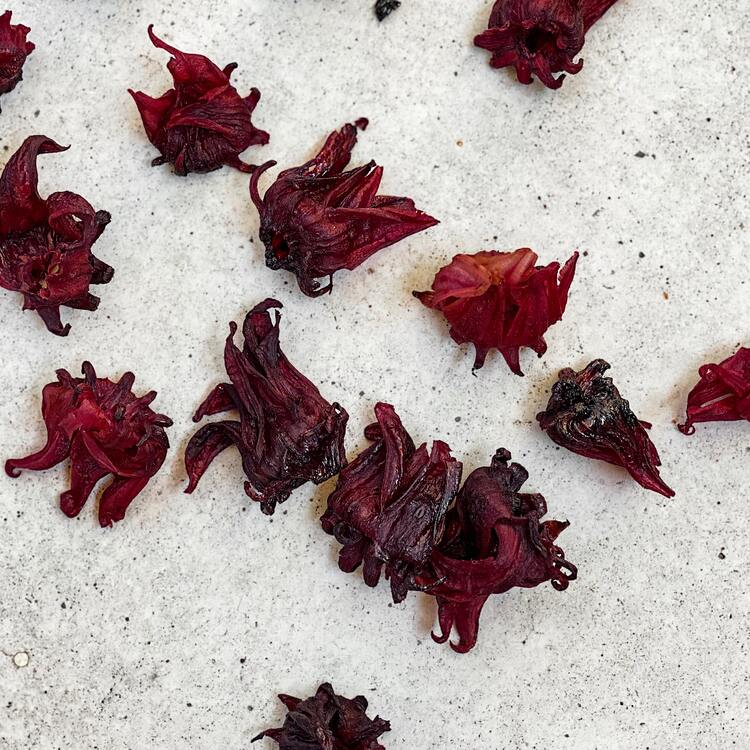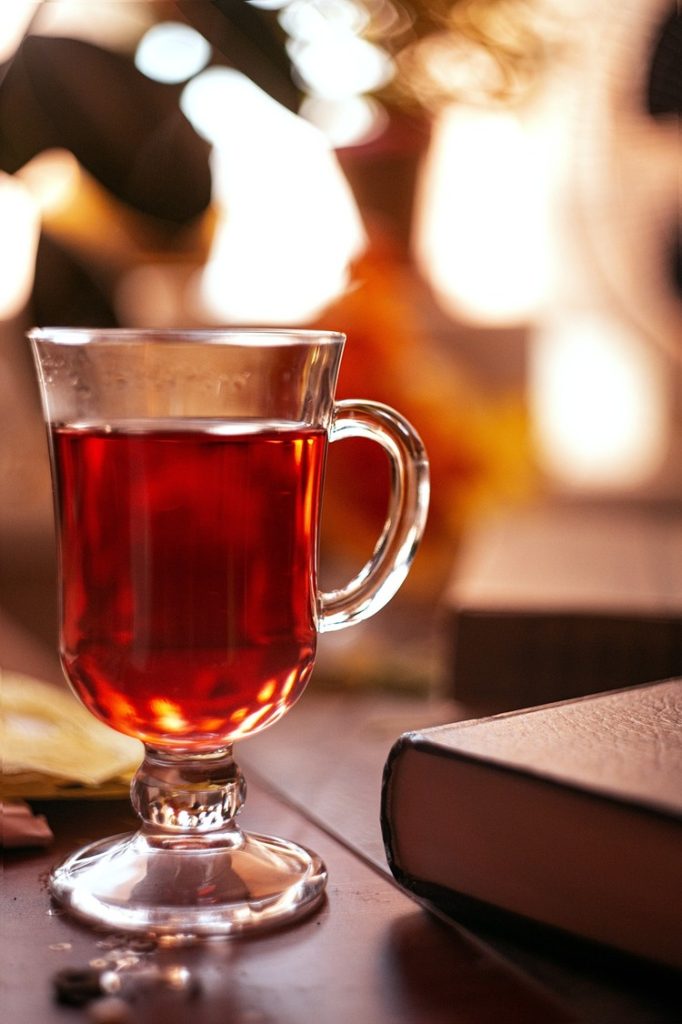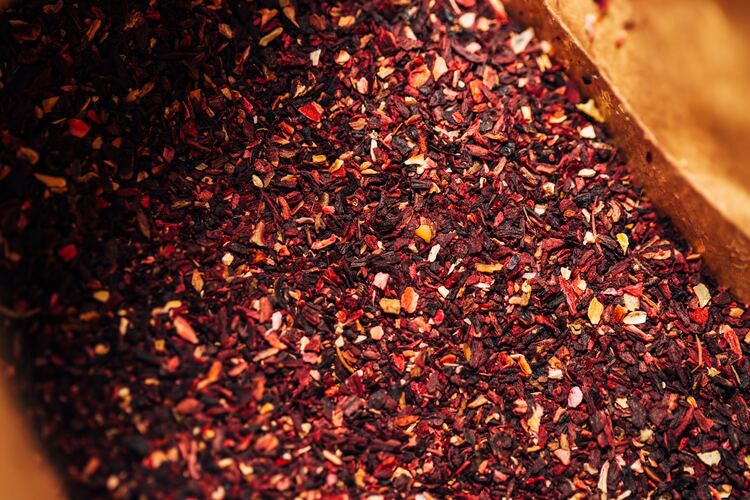Roselle hibiscus tea is a herbal tea made from the calyces of the Roselle plant, also known as Hibiscus sabdariffa. The plant is native to West Africa but is now grown in many tropical and subtropical regions worldwide.
Roselle tea has a tart, cranberry-like flavor and is often enjoyed hot or iced. It is a popular beverage in many countries, including Egypt, Mexico, and Thailand. In addition to its mouthwatering flavor, the tea is high in antioxidants and vitamin C, which may help boost your immune system and protect against chronic diseases.
Keep reading to learn more about this beloved.
Please note: This article contains affiliate links, meaning I may earn a commission if you make a purchase by clicking a link. Of course, this comes at no extra cost to you and helps me keep offering readers solid information.

What is Roselle Hibiscus Tea?
If you’re a tea lover, you may have come across roselle hibiscus tea, also known as Hibiscus tea, Red Sorrel, Rosella, Gongura, Pulicha Keerai, Florida Cranberry, Jamaica Sorrel, or Zobo.
In Mexico, the tea is known as “Agua de Jamaica.” In Egypt, it is known as “Karkadeh” and is a staple drink during Ramadan. In Thailand, the tea is known as “Nam Krajeab.” In Sudan, the tea is known as “Karkadi” and is a popular drink during celebrations and gatherings.
The tea is made from the dried calyces of the roselle hibiscus plant (Hibiscus sabdariffa). The calyces are the protective leaf-like structures that surround the flower bud. This tea is known for its vibrant red color and tart, tangy flavor.
The roselle plant is native to West Africa and is now grown in many parts of the world, including Asia, the Caribbean, and Central America. The plant is known for its vibrant red color, sometimes called “Red Tea.”
Roselle tea has a tart, tangy flavor that is refreshing and delicious. A lot of people compare the flavor to cranberries. It can be enjoyed hot or cold and is often sweetened with honey or sugar.
In addition to being consumed as a beverage, hibiscus tea is sometimes used as an ingredient in various culinary and cocktail recipes, adding flavor and color to dishes. It’s a versatile herbal beverage that appeals to a wide range of tastes.
Roselle Hibiscus Tea Taste and Aroma
The flavor profile of roselle hibiscus tea is characterized by its tart and tangy notes, accompanied by a pleasant and slightly fruity undertone. The tea has a lively and refreshing quality, making it a popular choice for those who enjoy beverages with a unique, zesty taste. The tartness is often compared to cranberries or sour cherries, providing a distinct and refreshing sensation on the palate.
When brewed, roselle hibiscus tea releases its vibrant red color into the water, adding to the beverage’s visual appeal. The aroma is often described as floral and slightly fruity, further enhancing the overall sensory experience.
Depending on personal preferences, some people enjoy hibiscus tea’s natural tartness without any added sweeteners, appreciating its natural flavors. Others may sweeten the tea slightly to balance the tanginess and create a more harmonious taste.

Ingredients and Preparation
You will need a few simple ingredients to make a delicious cup of roselle hibiscus tea.
The main ingredient is dried hibiscus flowers, which you can find at most health food stores or online. Depending on your taste preferences, you may want to include sugar, honey, cinnamon, and ginger.
To prepare the tea, boil four cups of water in a pot. Once the water is boiling, add one cup of dried hibiscus flowers and reduce the heat to a simmer. Let the flowers steep for 10-15 minutes or until the water turns a deep red.
Next, strain the tea through a fine mesh strainer or cheesecloth to remove the flowers. You can add sugar or honey to taste or leave it unsweetened. For an extra kick of flavor, add a cinnamon stick or a few slices of fresh ginger to the pot while the tea is steeping.
Once you’ve prepared it, you can enjoy it hot or chilled over ice.
Roselle Hibiscus Tea Variations
Other than the classic recipe, here are some variations you can enjoy.
Tropical Paradise Blend
Ingredients
- Dried roselle hibiscus calyces: 2 tablespoons
- Dried pineapple chunks: 1 tablespoon
- Dried coconut flakes: 1 tablespoon
- Water: 4 cups
- Sweetener (optional): Agave syrup or honey
Instructions
- Boil the water and remove it from the heat.
- Add the dried hibiscus calyces, pineapple, and coconut to the hot water. Let it steep for about 10-15 minutes.
- Strain the liquid to remove the calyces and other ingredients.
- If desired, sweeten the blend with your chosen sweetener.
- Allow the blend to cool, then refrigerate until chilled.
- Serve over ice for a tropical-inspired hibiscus tea experience.
Spiced Roselle Elixir
Ingredients
- Dried roselle hibiscus calyces: 2 tablespoons
- Cinnamon stick: 1
- Fresh ginger slices: 1 tablespoon
- Water: 4 cups
- Sweetener: Brown sugar or honey
Instructions
- Boil the water and remove it from the heat.
- Add the dried hibiscus calyces, cinnamon stick, and fresh ginger slices to the hot water. Let it steep for about 10-15 minutes.
- Strain the liquid to remove the calyces, cinnamon, and ginger.
- Sweeten the elixir to taste.
- Allow the elixir to cool, then refrigerate until chilled.
- Serve in small glasses as a spiced and invigorating beverage.
Berry Hibiscus Fusion
Ingredients
- Dried roselle hibiscus calyces: 2 tablespoons
- Mixed dried berries (such as blueberries, raspberries, or strawberries): 2 tablespoons
- Water: 4 cups
- Sweetener: Maple syrup or agave syrup
Instructions
- Boil the water and remove it from the heat.
- Add the dried hibiscus calyces and mixed dried berries to the hot water. Let it steep for about 10-15 minutes.
- Strain the liquid to remove the calyces and berries.
- Sweeten the fusion with your preferred sweetener.
- Allow the blend to cool, then refrigerate until chilled.
- Serve over ice for a refreshing berry-infused hibiscus tea.

Culinary Uses of Roselle Hibiscus
Consider trying roselle if you’re looking for a new ingredient to add to your culinary repertoire. This versatile plant offers a range of culinary uses, from sweet to savory.
The most commonly used part of the roselle plant is the calyx, which is the fleshy, red covering of the fruit. The calyx has a tart, cranberry-like flavor, making it perfect for beverages, jams, and jellies. You can also use it to make a refreshing tea, a popular beverage in many parts of the world.
Roselle flowers are also edible and can add color and flavor to salads, desserts, and other dishes. The flowers have a mild flavor that pairs well with fruits like strawberries and raspberries.
In addition to the calyx and flowers, other parts of the roselle plant can be used in cooking. The seeds can be roasted and ground into flour that can be used to thicken soups and stews. The seed pods can also be cooked and eaten like okra.
Roselle starch is another useful ingredient that can be used in a variety of dishes. It can be used as a thickener for sauces and gravies or added to breads and other baked goods to improve their texture.
Finally, roselle can be preserved in various ways, including pickling, canning, and drying. Preserved roselle can be used in many dishes, from savory stews to sweet desserts.
Roselle Hibiscus Tea Health Benefits
If you’re looking for a healthy and refreshing beverage, look no further than roselle tea. Here are some of the health benefits of this delicious tea:
- Packed with Antioxidants: Roselle Tea is rich in antioxidants, which help to neutralize harmful free radicals in your body. This can help to prevent damage to your cells and reduce the risk of chronic diseases.
- High in Vitamin C: Roselle Tea is a great source of vitamin C, which is essential for a healthy immune system. Drinking Roselle Tea can help to keep your immune system strong and protect you from illness.
- Good for Your Bones: Roselle Tea contains calcium, which is important for strong bones and teeth. Drinking Roselle Tea can help to keep your bones healthy and prevent osteoporosis.
- Acts as a Diuretic: Roselle Tea has diuretic properties, which can help flush excess fluids from your body. This can be helpful if you’re experiencing bloating or swelling.
- Rich in Iron: Roselle Tea is a good iron source, vital for healthy blood cells. Drinking Roselle Tea can help to prevent anemia and keep your energy levels up.
- Contains Anthocyanins: Roselle Tea contains anthocyanins, which are powerful antioxidants that have anti-inflammatory and antibacterial properties. Drinking Roselle Tea can help to reduce inflammation in your body and prevent infections.
- Lowers Hypertension: Roselle Tea has been shown to affect blood pressure levels positively. Drinking Roselle Tea can help to lower hypertension and reduce the risk of heart disease.
- Provides Essential Nutrients: Roselle Tea contains essential nutrients, including vitamins A and C, magnesium, and polyphenols. Drinking Roselle Tea can help to keep your body healthy and functioning properly.
- Good for Liver Health: Roselle Tea contains protocatechuic acid, which has been shown to have a protective effect on the liver. Drinking Roselle Tea can help to keep your liver healthy and prevent liver damage.
Buying Recommendations
When buying, look for dried roselle hibiscus calyces from reputable sources in well-sealed packages or containers. You can find them in specialty tea shops, health food stores, or online.
Check the color of the calyces. They should have a vibrant, deep red color. Faded or dull colors might indicate lower quality.
Read the packaging for any additional ingredients. Some blends might include other herbs or flavors, so make sure the product meets your preferences.
If you are thinking about buying online, please take into consideration these recommendations:

Hibiscus Flowers – 100% Natural


Store dried roselle hibiscus calyces in an airtight container, away from moisture, light, and heat. This helps maintain their flavor and color. Consider keeping the original packaging if it’s resealable, or transfer the calyces to airtight glass jars or containers with tight-fitting lids.
Store the container away from direct sunlight in a cool, dark pantry or cupboard. Avoid storing roselle hibiscus near strong-smelling spices or herbs, as it can absorb odors.
Frequently Asked Questions
How do you prepare dried Roselle tea?
To prepare dried Roselle tea, boil water and then add the dried Roselle flowers to the water. Let it steep for 10-15 minutes, strain the flowers, and enjoy your tea. You can add honey or other sweeteners to taste.
What are the benefits of Roselle tea for skin health?
Roselle tea is known to have antioxidants that can help protect your skin from damage caused by free radicals. It also has anti-inflammatory properties that can help reduce inflammation and redness on your skin.
How many calories are in a cup of Roselle tea?
A cup of Roselle tea typically has zero calories, making it a great option for those watching their calorie intake.
Where can I buy Roselle tea bags?
You can find Roselle tea bags at most health food stores or online. Read the label to ensure that the tea bags are made from pure Roselle flowers and do not contain additives or preservatives.
What does Rosella flower tea taste like?
Roselle tea has a tart and tangy taste, similar to cranberry juice. Some people also describe it as having a slightly floral flavor.
What is the flavor profile of Roselle tea?
Roselle tea has a unique flavor profile that is both tart and sweet. It has a refreshing taste that is perfect for hot summer days.

I have to admit this is one of my favorite teas! I hope you have enjoyed the article!
Have you tried it? Do you enjoy it often?
More About Floral Teas
What Does Jasmine Tea Taste Like?
What Does Chrysanthemum Tea Taste Like?
What Does Osmanthus Tea Taste Like?